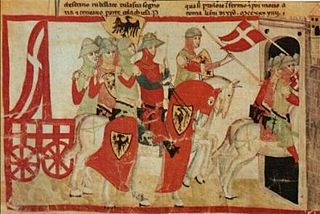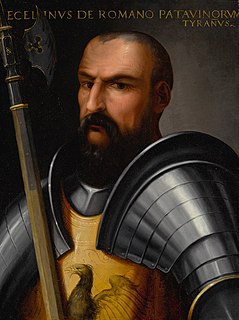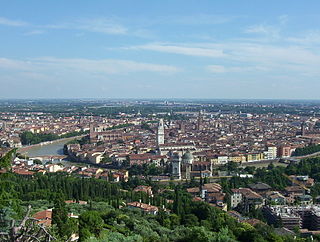Sources
- Rapisarda, Mario (1965). La signoria di Ezzelino da Romano. Udine.
Ezzelino I da Romano, also known as Ezzelino il Balbo (died 1189) was an Italian nobleman of the Ezzelini family, who was lord of Onara, Romano, Bassano and Godego.
The son of Alberico and the grandson of the family's founder, Ecelo, in 1148 he took part in the Second Crusade along Louis VIII of France and Conrad III of Germany, fighting in Damascus and Ashkalon. At his return to Italy, he received the fiefs of Oderzo and Mussolente.
In 1173 he was appointed as podestà of Treviso and, in the same period, he was also podestà of Vicenza. In 1175, together with Anselmo of Dovara, he commanded the Lombard League army who halted Frederick Barbarossa's march near Alessandria. In 1176 he led the Treviso troops in the battle of Legnano.
After the peace of Constance, he switched his allegiance from the Guelph to the Ghibelline party, and reconciled with the emperor. Ezzelino died in 1189 and was succeeded by his son Ezzelino II.

The Battle of Cortenuova was fought on 27 November 1237 in the course of the Guelphs and Ghibellines Wars: in it, Holy Roman Emperor Frederick II defeated the Second Lombard League.
The Ezzelini were a noble family in medieval Italy. The family was founded by Ecelo (Ezzelo), who received the fiefs of Romano d'Ezzelino and Onara

Ezzelino III da Romano was an Italian feudal lord, a member of the Ezzelino family, in the March of Treviso. He was a close ally of the emperor Frederick II, and ruled Verona, Vicenza and Padua for almost two decades. He became infamous as a cruel tyrant, and was, in fact, the most "notorious" of the "early tyrants".

The Della Scala family, whose members were known as Scaligeri or Scaligers, was the ruling family of Verona and mainland Veneto from 1262 to 1387, for a total of 125 years.
Martino della Torre was an Italian condottiero and statesman.

Events in the history of Verona, in Italy.

Cavaso del Tomba is a comune with about 3000 inhabitants in the province of Treviso, Veneto, north-eastern Italy. The municipality of Cavaso is spread over the southern flank of the buttress that extends from Monte Grappa towards the Piave River. It includes various villages, along its main road: Obledo, Caniezza, Paveion, Pieve, Vettorazzi, Granigo and Virago.
San Zenone degli Ezzelini is a comune (municipality) in the Province of Treviso in the Italian region Veneto, located about 50 kilometres (31 mi) northwest of Venice and about 35 kilometres (22 mi) northwest of Treviso.
Mastino I della Scala, born Leonardo or Leonardino, was an Italian condottiero, who founded the Scaliger house of Lords of Verona.
Cunizza da Romano was an Italian noblewoman and a member of the da Romano dynasty, one of the most prominent families in northeastern Italy, Cunizza's marriages and liaisons, most notably with troubadour Sordello da Goito, are widely documented. Cunizza also appears as a character in a number of works of literature, such as Dante Alighieri's Divine Comedy.

Reniero Zeno was the 45th Doge of Venice, reigning from 1 January 1253 until his death in 1268.

Jacopo Tiepolo, also known as Giacomo Tiepolo, was Doge of Venice from 1229 to 1249. He had previously served as the first Venetian Duke of Crete, and two terms as Podestà of Constantinople. During his first term, following the capture and mysterious end of Peter of Courtenay, Tiepolo acted as de facto ruler of the Latin Empire, negotiating treaties on behalf of the Empire with Egypt and the Seljuk Turks.
Alberico da Romano, called Alberico II, was an Italian condottiero, troubadour, and an alternatingly Guelph and Ghibelline statesman. He was also a patron of Occitan literature.
The Traversari are a noble Italian family. The dynasty's history was mostly connected to Ravenna, which it ruled between the 12th and 13th centuries. St. Romuald was the son of Duke Sergio degli Onesti of Ravenna and of Traversara Traversari, daughter of Teodoro Traversari, son of Paolo I Traversari.
Biaquino II da Camino was an Italian nobleman and military leader, a member of the da Camino family and lord of Treviso.

Ezzelino II da Romano, also known as Ezzelino il Monaco was an Italian nobleman of the Ezzelini family, who was lord of Onara, Romano, Bassano and Godego.

Pellegrino II was Patriarch of Aquileia in northern Italy from 1195 to 1204.
Giordano Forzatè, anglicized Jordan Forzatè, was a Paduan Benedictine monk and religious leader. For his noble background, peacemaking efforts and monastic reforms, the Chronicle of the Trevisan March calls him the pater Padue, "father of Padua".
Filippo da Pistoia, also called Filippo Fontana or anglicized Philip, was an Italian prelate, military leader and diplomat. He was the bishop-elect of Ferrara from 1239 until 1252, bishop-elect of Florence from 1250 until 1251 and archbishop of Ravenna from 1250 until his death. He was the apostolic legate in Germany between July 1246 and March 1247, in Lombardy and the Trevigiana between December 1255 and August 1258 and throughout northern Italy between 1267 and February 1270. He served as podestà (mayor) of Ravenna in 1254.
Guglielmo Cortusi (fl. 1305–1361) was a Paduan judge, diplomat and chronicler whose Chronica de novitatibus Padue et Lombardie is the principal primary source for Paduan history in the early years of Carraresi rule.